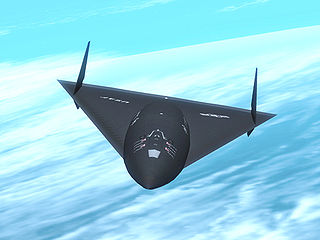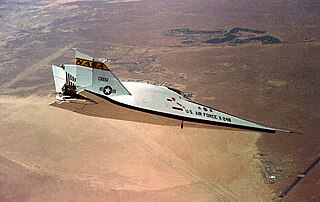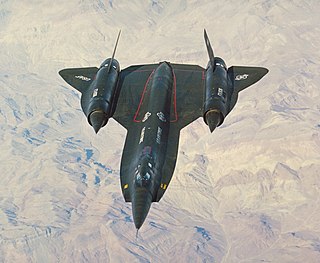
A ramjet is a form of airbreathing jet engine that requires forward motion of the engine to provide air for combustion. Ramjets work most efficiently at supersonic speeds around Mach 3 and can operate up to Mach 6.

Aurora is a rumored mid-1980s American reconnaissance aircraft. There is no substantial evidence that it was ever built or flown and it has been termed a myth.
A liquid air cycle engine (LACE) is a type of spacecraft propulsion engine that attempts to increase its efficiency by gathering part of its oxidizer from the atmosphere. A liquid air cycle engine uses liquid hydrogen (LH2) fuel to liquefy the air.

The North American X-15 is a hypersonic rocket-powered aircraft operated by the United States Air Force and the National Aeronautics and Space Administration (NASA) as part of the X-plane series of experimental aircraft. The X-15 set speed and altitude records in the 1960s, crossing the edge of outer space and returning with valuable data used in aircraft and spacecraft design. The X-15's highest speed, 4,520 miles per hour, was achieved on 3 October 1967, when William J. Knight flew at Mach 6.7 at an altitude of 102,100 feet (31,120 m), or 19.34 miles. This set the official world record for the highest speed ever recorded by a crewed, powered aircraft, which remains unbroken.

A scramjet is a variant of a ramjet airbreathing jet engine in which combustion takes place in supersonic airflow. As in ramjets, a scramjet relies on high vehicle speed to compress the incoming air forcefully before combustion, but where as a ramjet decelerates the air to subsonic velocities before combustion using shock cones, a scramjet has no shock cone and slows the airflow using shockwaves produced by its ignition source in place of a shock cone. This allows the scramjet to operate efficiently at extremely high speeds.

The Martin Marietta X-24 was an American experimental aircraft developed from a joint United States Air Force-NASA program named PILOT (1963–1975). It was designed and built to test lifting body concepts, experimenting with the concept of unpowered reentry and landing, later used by the Space Shuttle. Originally built as the X-24A, the aircraft was later rebuilt as the X-24B.

The Lockheed YF-12 is an American Mach 3+ capable, high-altitude interceptor prototype, developed and manufactured by American aerospace company Lockheed Corporation.

The NASA X-43 was an experimental unmanned hypersonic aircraft with multiple planned scale variations meant to test various aspects of hypersonic flight. It was part of the X-plane series and specifically of NASA's Hyper-X program developed in the late 1990s. It set several airspeed records for jet aircraft. The X-43 is the fastest jet-powered aircraft on record at approximately Mach 9.6.

The Lockheed D-21 is an American supersonic reconnaissance drone. The D-21 was initially designed to be launched from the back of an M-21 carrier aircraft, a variant of the Lockheed A-12 aircraft. The drone had maximum speed in excess of Mach 3.3 at an operational altitude of 90,000 feet. Development began in October 1962. Originally known by the Lockheed designation Q-12, the drone was intended for reconnaissance deep into enemy airspace.

The Rockwell X-30 was an advanced technology demonstrator project for the National Aero-Space Plane (NASP), part of a United States project to create a single-stage-to-orbit (SSTO) spacecraft and passenger spaceliner. Started in 1986, it was cancelled in the early 1990s before a prototype was completed, although much development work in advanced materials and aerospace design was completed. While a goal of a future NASP was a passenger liner capable of two-hour flights from Washington to Tokyo, the X-30 was planned for a crew of two and oriented towards testing.

The DARPA FALCON Project was a two-part joint project between the Defense Advanced Research Projects Agency (DARPA) and the United States Air Force (USAF) and is part of Prompt Global Strike. The first part of the project aimed to develop a Small Launch System (SLS) capable of accelerating hypersonic gliding weapons as well as launching small satellites into Earth orbit. The second part of the project aimed to develop Hypersonic Weapon Systems (HWS): a short term high performance hypersonic gliding weapon previously named the X-41 Common Aero Vehicle (CAV) that could be launched from Expendable Launch Vehicles (ELV), Reusable Launch Vehicles (RLVs), Hypersonic Cruise Vehicles (HCV), or Space Maneuvering Vehicles (SMP), and a long term hypersonic cruise aircraft named the Hypersonic Cruise Vehicle (HCV). This two-part program was announced in 2003 and continued into 2006.

The Boeing X-51 Waverider is an unmanned research scramjet experimental aircraft for hypersonic flight at Mach 5 and an altitude of 70,000 feet (21,000 m). The aircraft was designated X-51 in 2005. It completed its first powered hypersonic flight on 26 May 2010. After two unsuccessful test flights, the X-51 completed a flight of over six minutes and reached speeds of over Mach 5 for 210 seconds on 1 May 2013 for the longest duration powered hypersonic flight.
Scramjet programs refers to research and testing programs for the development of supersonic combustion ramjets, known as scramjets. This list provides a short overview of national and international collaborations, and civilian and military programs. The USA, Russia, India, and China (2014), have succeeded at developing scramjet technologies.

Balls 8 is a NASA Boeing NB-52B mothership which was retired in 2004 after almost 50 years of flying service with NASA. The aircraft is famous for dropping the X-15 aerospace research vehicle on 106 of the 199 X-15 program flights.

Hypersonic flight is flight through the atmosphere below altitudes of about 90 km (56 mi) at speeds greater than Mach 5, a speed where dissociation of air begins to become significant and high heat loads exist. Speeds over Mach 25 have been achieved below the thermosphere as of 2020.

The Ayaks is a hypersonic waverider aircraft program started in the Soviet Union and currently under development by the Hypersonic Systems Research Institute (HSRI) of Leninets Holding Company in Saint Petersburg, Russia.

The HSTDV is an unmanned scramjet demonstration aircraft for hypersonic flight. It is being developed as a carrier vehicle for hypersonic and long-range cruise missiles, and will have multiple civilian applications including the launching of small satellites at low cost. The HSTDV program is being run by the Defence Research and Development Organisation (DRDO).

The Lockheed Martin SR-72, colloquially referred to as "Son of Blackbird", is an American hypersonic UAV concept intended for intelligence, surveillance and reconnaissance (ISR) proposed privately in 2013 by Lockheed Martin as a successor to the retired Lockheed SR-71 Blackbird. In 2018, company executives said an SR-72 test vehicle could fly by 2025 and enter service in the 2030s.

A hypersonic weapon is a weapon capable of travelling at hypersonic speed, defined as between 5 and 25 times the speed of sound or about 1 to 5 miles per second.
SCIFIRE, or the Southern Cross Integrated Flight Research Experiment, is an American-Australian military technology partnership that is developing a solid-rocket-boosted, air-breathing, hypersonic conventionally-armed cruise missile that can be launched by existing fighter or bomber aircraft.

















